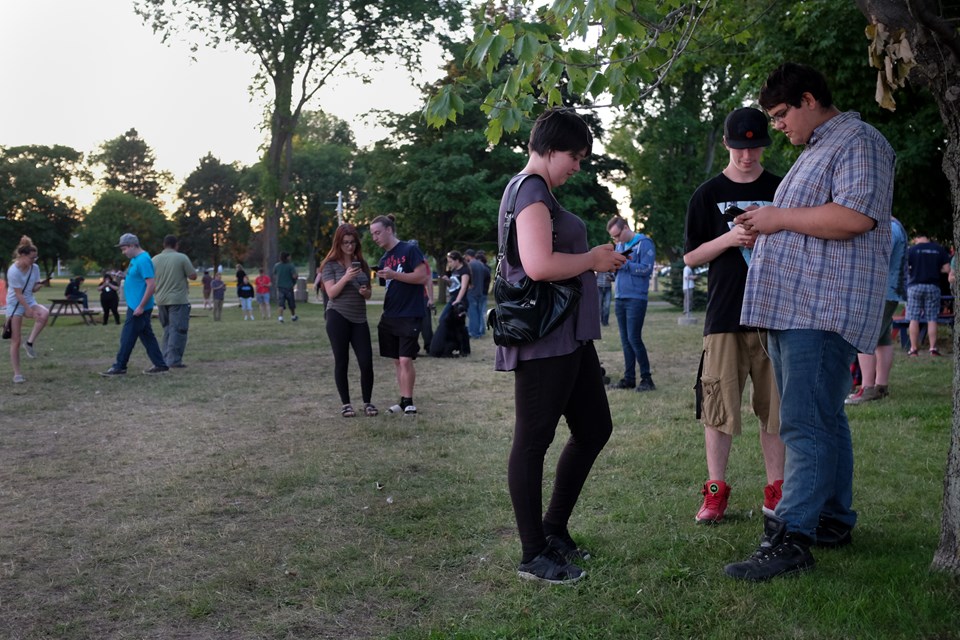
The Dangerous Digitalisation of Pokémon Go
For internet hermits sitting on benches in parks and squares over the past month people-watching must have taken on a repetitive spin: swathes of young men and women popping up to meander through public space, glued to their iPhone 6, and only lifting their heads to exchange brief but excited chatterings to other similar looking individuals.
For anyone who has entered the digital age, they will recognise this phenomenon as the latest craze: Pokémon Go. Launched in the US a month ago and the UK the following week, the app has already notched up over 100 million downloads and is earning its developers an average of 10 million dollars a day. For anyone unfamiliar with Pokémon, the aim of the game is to go out into the world and catch every single Pokémon, which are animals that can be trained to fight. The difference between Pokémon Go and every other game in the franchise is that rather than trying to ‘Catch ‘Em All’ from the comfort of your home, Pokémon Go requires the player to go out into the real world to find each digital creature. Unlike in traditional gaming, players can have serious if indirect consequences on the real world. Already players have found numerous dead bodies, caused major traffic accidents, and two weeks ago in Guatemala an eighteen year-old boy became the first person to be killed while playing Pokémon Go.
Despite these complications, Pokémon Go has been heralded as a revolutionary milestone in gaming. For parents whose conception of gaming goes hand in hand with their kids sitting in front of a screen for six hours, the game has probably been a blessing. Undoubtedly it’s healthier that the compulsive behaviour that any decent game manifests in its players is carried out outside, rather than in vitamin D deprived caverns of virtual reality. It can also be a good way of meeting new people, as it is very easy to pick out other players, by the way they rush and stop so suddenly, and for their relentless focus on their phone. But the argument in favour of the game that I’ve heard most is that it encourages some normally quite reclusive people to get outside and engage in the real world. And it is this argument that I disagree with the most. I should say now that I enjoy a bit of FIFA as much as the next person, and used to play a fair amount of Call Of Duty back in the day, so this is not a criticism of gaming in general—but rather, its recent entry into the outside world.
What Pokémon Go has achieved is to translate the virtual experience of gaming from the sofa to the streets, and in doing so it has pushed a huge number of people one stop further from reality. Before Pokémon Go, even for the all-day gamer, the occasional trip outside meant having to have some sort of ‘real’ experience, and a social interaction without their games console. But now gaming has gone mobile, instead of seeing a tree or a park, players will see a Pokéstop or the perfect place to catch some more Pokémon. It gets even more depressing when you think about how you catch Pokémon on the game. While walking around, Pokémon pop up on your phone’s GPS and you have to get within their radius in order to confront them. Once you do this the game activates your camera and the Pokémon pops up with whatever your camera is showing in the background, whether that is a tree or a lamppost, someone who is trying to talk to you or an oncoming car: the game presents the player with a projection of virtual reality on to the outside world. The act of catching Pokémon is the climax of the game, and therefore it stands to reason that the point at which players are paying most attention to their surroundings, is, paradoxically, when they are looking at them on their screen.
Apart from the fact that it’s sad to see more people than usual walking around attached to their phones, the really gloomy thing about Pokémon Go is not the game itself, but what it represents. The popularity of Pokémon Go will probably soon fade but its concept won’t. As technology improves, GPS-based gaming will become more advanced, and as it does, the line between virtual and non-virtual reality will diminish. Watching people play over the past month has often reminded me of the film Wall-E, where fat people are automatically transported around on hovering chairs, completely locked to whatever is on the screen in front of their eyes. It is only until a man and a woman fall off their chairs that they discover the joy of not being in front of a screen, and they play around in a nearby pool. While this parallel is a bit melodramatic, it might very well be close to where we are heading.
Pokémon Go is only the first step towards the transformation of the outside world into digital space. With its release the potential breeding ground for real experience has become that bit smaller. It’s better to have people spend all day gaming inside than to do the same but split it between their bedroom and their local park. And that is because gaming should remain exclusive from reality. I’m not talking about gaming conventions, or conversations about the latest release, but the experience of a video game itself. There has to be a distinguishable line between what is real and what isn’t. Before Pokémon Go, that was arguably the door that separated the inside and outside areas of your life. But that line has now become significantly blurred, and while you can choose not to play Pokémon Go, the fact that you now have that choice is a technological milestone that I’d rather we had never reached.







